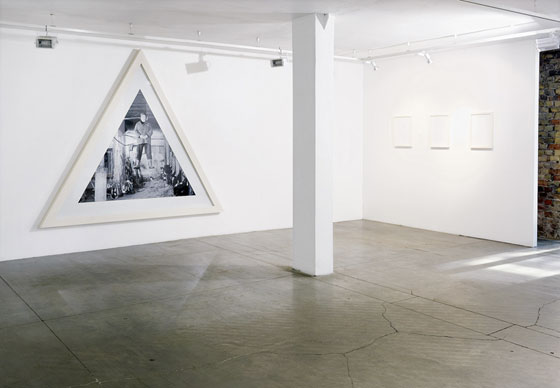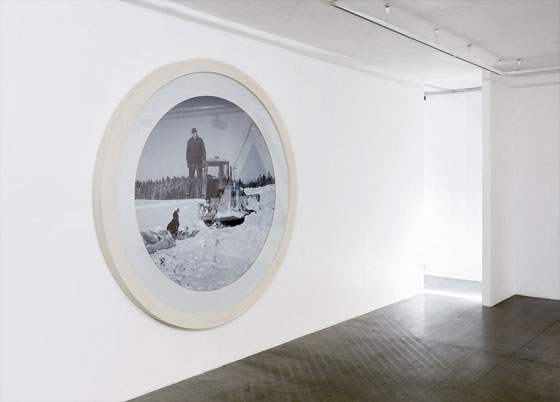|
|
| Jumping beyond the horizon Jānis Borgs, Art Critic Kaspars Podnieks. Communicating Vessels 18.02.–27.03.2011. Contemporary Art Centre kim? | |
| The Contemporary Art Centre kim? has once again managed to attract attention with an intellectually “honed” event – an exhibition Communicating Vessels by the ‘young and promising’ (nominated for the Purvītis Award, after all), smiled-on-by-Fortune artist Kaspars Podnieks. All the works seen at the exhibition were united in a trinity of form of some sort. Already at first sight, an obvious formal and essential correlation among the displayed objects was visible, an ensemble, so to speak, or to put it in the words of the author – truly “communicating vessels”. To make sure there wouldn’t be any room for doubt, a textual introduction to the exhibition was made available. However, this made one proceed with caution and aroused a slight feeling of scepticism even before seeing the exhibition. The artist (or the curator?), with the best of intentions – to lead the viewer to a ‘correct’ understanding of the works exhibited – provided the apparently hidden key to viewing the exhibition. One more case where the source of inspiration for art has been found on the shelves of scientific discoveries (this time the dustiest ones). And here too the physical principle of communicating vessels was quite profoundly explained, even quoting Pascal’s law. Although the motivation for substantiating the concept behind a piece of art appears to be fairly pseudoscientific and the whole big deal is centred around elementary primary school knowledge, you have to give in – what does it matter, who or what inspired someone’s creative activity? Unfortunately, from time to time when cooking up the concepts of “new art”, contemporary authors are not able to drag themselves much beyond the confines of puerility. It is a rare occasion when an artist can express the ideas of avant-garde science which would demand at least a higher degree in the sciences. Yet the splendour and the “mystique” of the countless triumphs of science have enchanted many, and the magic of science has hypnotized more than one overachiever in the humanities. And then, of course, a reference to science seemingly lends weight to a work of art. Has anyone ever heard, however, of scientists finding their sources of inspiration in works of art? Something to think about… | |
 Kaspars Podnieks. Communicating Vassels. 2011 | |
| But it is not the explanations or commentaries that determine the value of an exhibition. Here the value was revealed with convincing force by the works themselves. Displaying an almost Malevich-like monumental clarity, Kaspars Podnieks presented a formula of the three basic geometric shapes – the square, the circle and the triangle – which in exposition revealed themselves in three different variations of interaction, correlation and relationship. Just as the author had intended – like the flow of liquid in communicating vessels. The thick wooden frames, modelled in the shapes of the geometric forms mentioned, closely “embrace” three large photographs. It could seem a little strange that the critique is first of all focussed on these frames. But it cannot be denied – the outstanding carpentry work made it obvious that they had been done by a professional, and may be a kind of professional nostalgia from the times when Kaspars Podnieks was studying at the Wood Design department of the Riga College of Applied Arts. The images within these frames, for their part, one would not want to associate with fine art photography, rather they are the photo documentation of an event. The event is the “miraculous” levitation of the author himself, at various low heights above the ground, like a Latvian yogi of sorts. Of course, the viewer being well-versed in the benefits of civilization might not believe in the miracle and merely sneer morosely at yet another digital stunt. Or photomontage? One reminiscent of the work Leap into the Void presented by French avant-garde artist Yves Klein in 1960. However, “sources” reveal that here Podnieks had really suspended himself in the air with the help of some hidden technology. Or maybe the artefact contains something of Chinese circus acrobatics? The static pose of Podnieks also testifies to the fact that he was not using the method of the great classic photographer Philippe Halsman, that of having people jump up in the air. The exhibition didn’t reveal the trick of the trade, so the technical intrigue was maintained. Obviously, there can be various methods of “levitation”. The author himself notes rather plaintively in an interview: “(…) in art everything has already been said, what else new is there to create?” A thought that one cannot agree with. And even if “everything” had been said, then the question “how” still remains eternally relevant. And what still remains important for us is the message – that which the author of the artwork, Kaspars Podnieks, has wanted to convey. Yves Klein used the leap to portray an urban man reaching Nirvana; for Philippe Halsman the jump was a radical means of heightened expressiveness to make his photo subjects seem free as birds; Kaspars Podnieks, for his part, conveys a completely different message – perhaps his metaphysical ties with the familiar environment of his native Drusti village. It seems that here one can observe a rather paradoxical combination: a blend of urban intellectualism with Latvian country mentality, which hints at a kind of peasant slyness, practicality, faith and even naiveté and sincerity of the artist that he himself admits: “When I create art, essential reference points and objects of investigation are connected with Drusti. That’s where I come from and that’s where I am. That’s where I feel secure that my work will be genuine and thus useful to others.” | |
 Kaspars Podnieks. Communicating Vassels. 2011 | |
| The consistent and endless levitations of Kaspars Podnieks are reminiscent of the grand Age of the Baroque, when practically everything in art seemed to be immune to gravity. Gods, angels and saints, heroes in coats of armour and plump naked women, pegasuses and ordinary nags were all flittering about in clouds illuminated by the rays of the sun… This whole world of allegorical emotionalism stirred up by the Renaissance swept over Europe like a steamroller, before it was modestly folklorized and landed back on earth, for example, in the pottery work of our own ceramic artist Ontons of Latgale. Our Podnieks, on the other hand, manifests himself in a pose which conveys a deeper message only if viewed in the context of the environment. The performance of Kaspars Podnieks reminds me of something I observed during a trip in China. Everywhere I went I tried to photograph the Chinese people I met on the way. They were greatly responsive. But during these spontaneous photo sessions I discovered a significant cultural difference which I had never seen in Europe. Many young Chinese people, who were otherwise joyful and carefree, upon seeing the camera lens stood up very straight with their arms down their sides. A little similar, but far more rigidly than Podnieks in his photos. It was the classic military position of attention. In these cases I felt like a general receiving a report from a new recruit. This occurrence could only be explained by knowing the enormously influential role and authority within society that the army still has in China. For many people in China the army provides the best career opportunities and it is like one model of an ideal life. The position of attention assumed by Kaspars Podnieks in front of viewers has more to do with the folklorism of the good soldier Švejk, which does not represent the importance of a superstate, but rather reveals the experience of the harshness of daily practical life. Perhaps it could be compared to the pride of the farmer standing next to a freshly slaughtered pig. Podnieks himself is one of the communicating vessels in whom the liquid substances of Latvian reality are constantly being balanced out. It is a world where the artist sees himself as a locally anthropocentric being or axis, around which the swarm of all known surrounding things revolves. The artist as if seeks and even finds a certain balance between himself, or the Human, and this eternally changing environment. But the declared balance looks to be all too fragile. There is an unpleasant twinge in the pit of the stomach, as if watching a pyramid of glassware stacked up on the forehead of a juggler. Switch on the TV news before going to bed: everything falling to pieces and tumbling down… But Crazy Dauka (Dullais Dauka) is still rowing on, regardless, to find out what is beyond the horizon… /Translator into English: Vita Limanoviča/ | |
| go back | |







